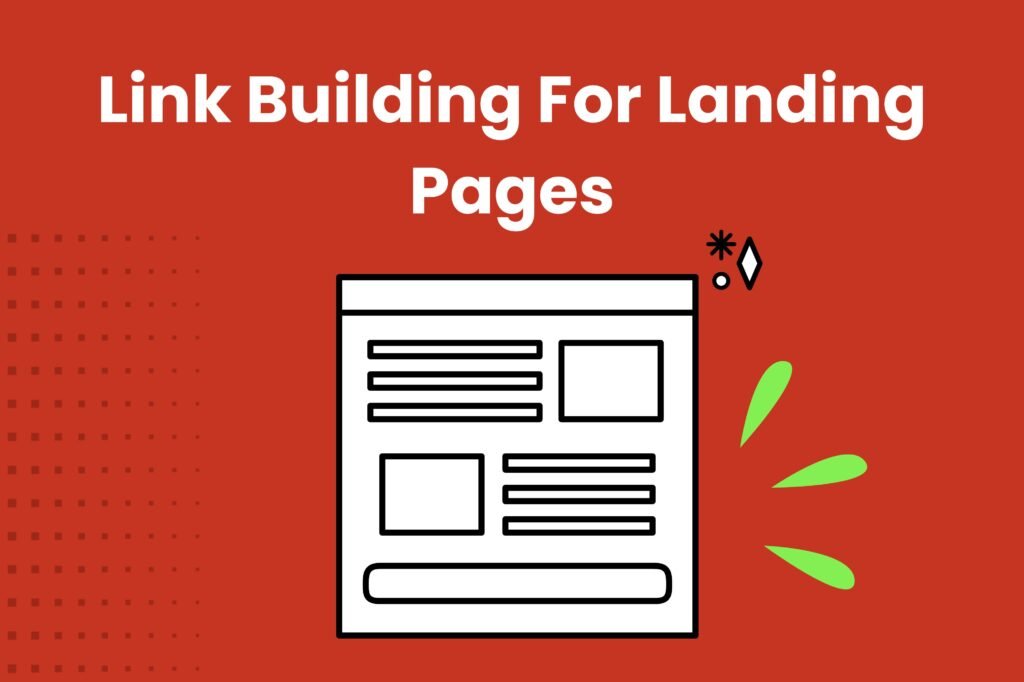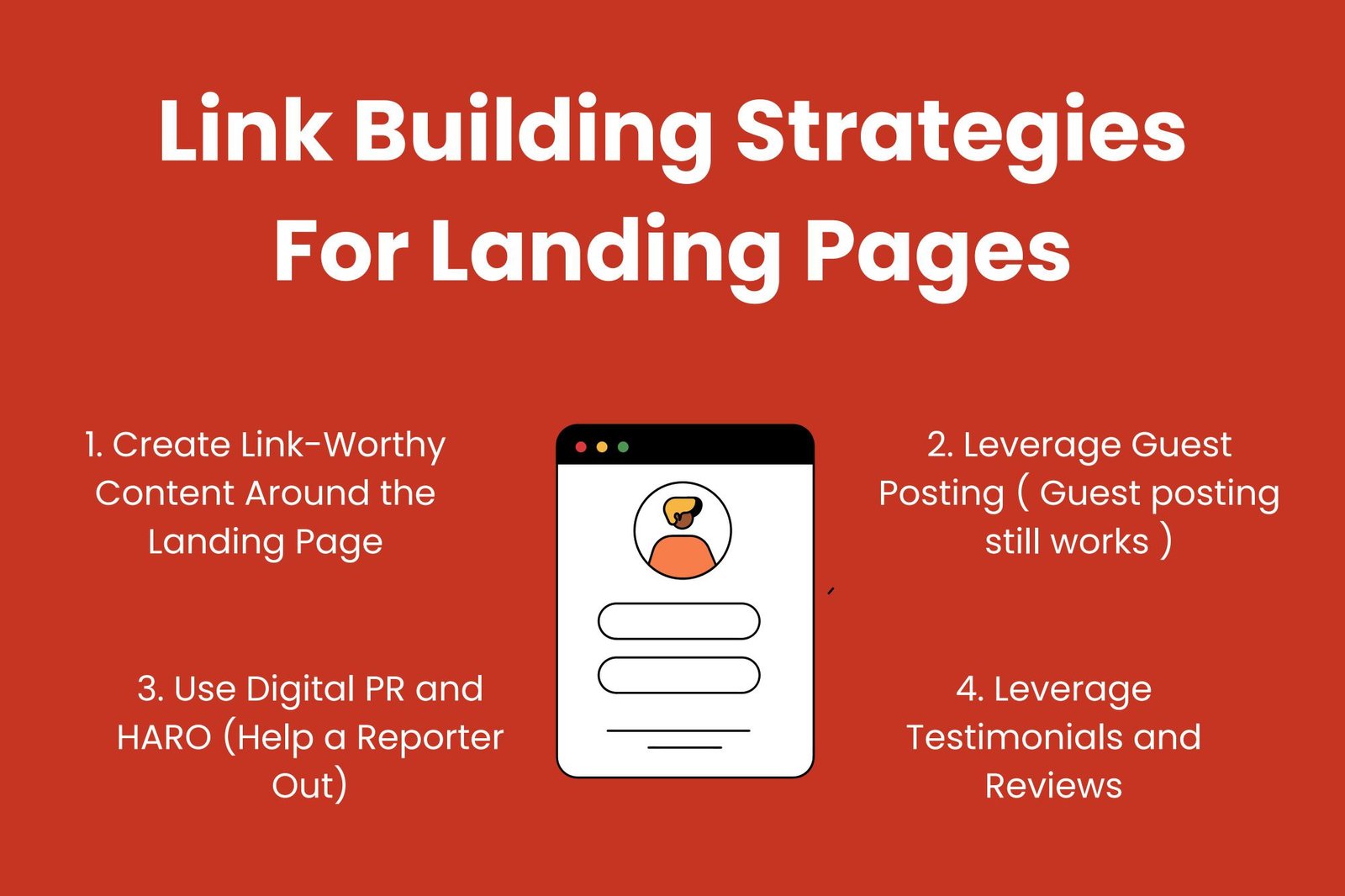
Landing pages are the heartbeat of conversions. Whether you’re promoting a product, collecting leads, or driving sign-ups, your landing page needs visibility. And what’s the best way to get that visibility? You guessed it — link building.
In this comprehensive guide, I’ll walk you through effective strategies, common mistakes to avoid, and how to track your progress. I’ll also sprinkle in some personal insights and actionable tips I’ve learned from years of SEO experience
Why Link Building Matters for Landing Pages
Before we dive into tactics, let’s talk about why link building for landing pages is different from link building for blog posts or homepages.
- Landing pages are usually more sales-focused — which means people are less likely to link to them naturally.
- You need to balance SEO with user experience — your landing page should convert visitors, not just rank well.
- High-quality backlinks signal trust to Google — crucial for pages asking users to take action (buy, sign up, etc.).
When done right, building links to your landing pages will:
- Improve your rankings for targeted, high-converting keywords
- Drive qualified traffic from referring domains
- Strengthen the authority of your entire domain
Link Building Strategies for Landing Pages

1. Create Link-Worthy Content Around the Landing Page
Let’s be honest: no one wants to link to a page that just screams “Buy Now!” But if you surround your landing page with valuable resources, linking opportunities skyrocket.
Example: Suppose you’re promoting a project management SaaS tool. Create an in-depth guide on “How to Choose a Project Management Tool” and internally link to your landing page within that guide.
2. Leverage Guest Posting
Guest posting still works — if you do it thoughtfully. Find niche-relevant blogs and offer them valuable, original content. Within your guest post, link to your landing page in a way that feels natural.
Tip: Don’t force it. If the landing page link doesn’t add value, link to a related blog post instead and then guide users internally.
3. Use Digital PR and HARO (Help a Reporter Out)
Journalists and bloggers often look for expert insights. Sign up for HARO or similar platforms, and respond to queries where your landing page can add value.
4. Partnerships and Resource Pages
Reach out to businesses or organizations in your niche. Offer them exclusive deals or content in exchange for a link on their resource or partner page.
5. Leverage Testimonials and Reviews
Offer testimonials to the tools, services, or products you use — and include a link to your landing page in your author bio or testimonial credit.
6. Run Contests, Giveaways, or Offer Tools
Free tools, templates, or contests attract links like magnets. Make your landing page the central hub for such campaigns.
7. Broken Link Building
Find broken links on niche-relevant sites. Offer your landing page (if genuinely relevant) as a replacement.
Bullet-Point Recap of Strategies:
- Create supportive content and internally link to the landing page
- Guest post on niche-relevant blogs
- Respond to journalist queries (HARO, Terkel, etc.)
- Get listed on partner/resource pages
- Give testimonials for products/services you use
- Run free tools, contests, or giveaways
- Offer to replace broken links on relevant sites
Analytics: How to Measure Link Building Success for Landing Pages
Getting links is great — but are they actually helping you achieve your business goals? Without proper analytics, you’re flying blind. Let’s explore in more detail how to measure link building performance for your landing pages, so you can fine-tune your strategy and maximize ROI.
Key Metrics to Track
Here’s what you should be monitoring to assess the impact of your link building efforts:
- Referral Traffic — Are people actually clicking on your backlinks and visiting your landing page? Analyze not just quantity, but also quality: Are these visitors engaging with your content, or bouncing right away?
- Keyword Rankings — Is your landing page climbing the search engine results pages (SERPs) for your target keywords? Track both primary and secondary keywords over time to see if link building is pushing you upward.
- Conversions — Ultimately, this is what matters most. Are backlinks contributing to form fills, sign-ups, purchases, or other key conversion actions? Pay attention to conversion rates from referral sources.
- Domain Authority of Linking Sites — High-authority sites passing link equity to your landing page can significantly boost your SEO. Use tools to monitor the strength of the domains linking to you.
- Engagement Metrics — Look at time on page, pages per session, and bounce rate for visitors coming via backlinks. Strong engagement signals that you’re attracting the right audience.
- Growth of Linking Root Domains — Not just the number of backlinks, but how many unique domains are linking to your page. A diverse backlink profile is healthier and more powerful.
Recommended Tools
- Google Search Console — Monitor keyword rankings, indexing status, and see which domains are linking to your page.
- Google Analytics (GA4) — Track referral traffic, user behavior, and conversions. You can create custom reports to drill down into landing page performance from backlinks.
- Ahrefs / SEMrush / Moz — Check the quality, anchor text, and authority of backlinks. These tools can also help you benchmark against competitors.
- Looker Studio (formerly Data Studio) — Visualize data from GA4, Search Console, and other sources in easy-to-understand dashboards.
Pro Tips for Measuring Success
- Set Up Conversion Goals and Events: In Google Analytics, create specific goals (e.g., form submissions, downloads) tied to your landing page so you can measure exactly how links contribute to business outcomes.
- Segment by Referral Source: Analyze how traffic and conversions differ by backlink source. This helps you identify which sites send the most valuable traffic.
- Monitor Over Time: Link building is a long game. Review metrics monthly or quarterly to spot trends, rather than expecting immediate results.
- Use UTM Parameters for Outreach Links: When you manually secure a backlink (e.g., through guest posts or partnerships), use UTM parameters so you can track performance precisely in your analytics tools.
By consistently analyzing these data points, you’ll gain valuable insights into what’s working, what’s not, and where to focus your link building efforts next.
Common Mistakes in Link Building for Landing Pages
I’ve seen (and made) these mistakes over the years. Avoid them to save time and headaches.
1. Only Focusing on Quantity Over Quality
A few high-authority, niche-relevant links will outperform dozens of spammy ones.
2. Over-Optimizing Anchor Text
If every link uses the exact same keyword-rich anchor text (e.g., “best project management software”), it looks unnatural. Mix it up.
3. Neglecting Internal Links
Your own site is your best friend. Build internal links from your blog posts and other pages.
4. Building Links to the Wrong Page
Sometimes, it’s smarter to link to a blog post or resource and guide users to your landing page from there.
5. Not Tracking Results
If you don’t measure impact, how will you know what’s working?
Advanced Tips to Supercharge Your Link Building
If you want to take your landing page link building to the next level, these advanced tactics will help you stand out and attract powerful, long-lasting links. Let’s break them down in more detail, so you can apply them confidently.
Build a Content Cluster
Surround your landing page with high-value blog posts, case studies, whitepapers, videos, and downloadable resources that all interlink and point to your main offer. This approach builds topical authority and gives Google more context about your expertise in a particular subject area. A well-structured content cluster also keeps users engaged, increases time on site, and lowers bounce rates — all positive SEO signals. You can take it further by creating a pillar page that ties together all these resources, providing a comprehensive experience that search engines love and users find valuable.
Local Citations
If your landing page represents a local service, office, or location-specific offer, getting listed in local directories, industry-specific portals, and business listings can provide highly relevant backlinks. Think beyond Google Business Profile: target directories like Yelp, Justdial, niche association directories, chamber of commerce sites, and respected local blogs. These citations strengthen your local SEO signals, improve trust with search engines, and can directly drive foot traffic or service inquiries.
Sponsor Niche Events or Podcasts
Sponsoring virtual events, webinars, conferences, or industry-specific podcasts can earn you high-authority backlinks and increase your brand visibility. Look for sponsorships that offer inclusion on event websites, promotional pages, speaker bios, or recap posts. Even small local meetups or emerging industry podcasts can provide valuable links and exposure. This tactic not only boosts SEO but also helps position your brand as an engaged and supportive community player.
Create Visual Assets
Infographics, flowcharts, comparison tables, or interactive tools related to your landing page topic are powerful link magnets. Visual content simplifies complex ideas and makes them easy to share or embed. When you create compelling visual assets, be sure to host them on your landing page or an associated blog post, and promote them proactively. Consider submitting your infographic to infographic directories, sharing it on social media, and offering it to niche blogs as a free resource.
Bonus Tip: Amplify and Repurpose Your Efforts
Creating great assets or earning sponsorships is just the beginning. Actively promote your content clusters, visuals, and partnerships through email outreach, social media, LinkedIn posts, Reddit threads, and relevant online communities. Repurpose infographics into short videos, slide decks, carousels, or downloadable templates. The more touchpoints you create, the more opportunities you have to attract organic backlinks and build brand authority.
By layering these advanced techniques, you’ll not only build stronger links but also create a web of content and relationships that reinforce your landing page’s SEO power for the long term.
Frequently Asked Questions (FAQs) About Link Building for Landing Pages
1. Should I build links directly to my landing page or to supporting content?
Both strategies have merit. Direct links to your landing page can improve its authority and rankings, but many sites are hesitant to link to sales-focused pages. Supporting content (like blog posts) often attracts links more easily and can funnel visitors internally to your landing page.
2. Are paid links a good idea for landing pages?
Paid links violate Google’s guidelines and can lead to penalties. It’s far better to focus on earning links organically through valuable content, partnerships, and ethical outreach.
3. How many backlinks does my landing page need to rank?
There’s no magic number — it depends on your competition, niche, and the authority of linking domains. Focus on earning high-quality, relevant links rather than hitting an arbitrary target.
4. Can internal links help my landing page rank?
Absolutely! Internal links from related content signal to Google that your landing page is important. They also guide visitors smoothly through your site.
5. How do I monitor backlinks to my landing page?
Use tools like Google Search Console, Ahrefs, or SEMrush to track backlinks. Regularly review them to ensure you’re earning quality links and disavow any spammy ones that could hurt your SEO.
Final Thoughts: Focus on Value, Not Just Links
Link building for landing pages isn’t easy — but it’s 100% worth the effort. By focusing on value, relevance, and authenticity, you’ll not only improve your rankings but also build real trust with your audience.
Remember: your goal isn’t just to rank higher. It’s to drive meaningful traffic that converts.
